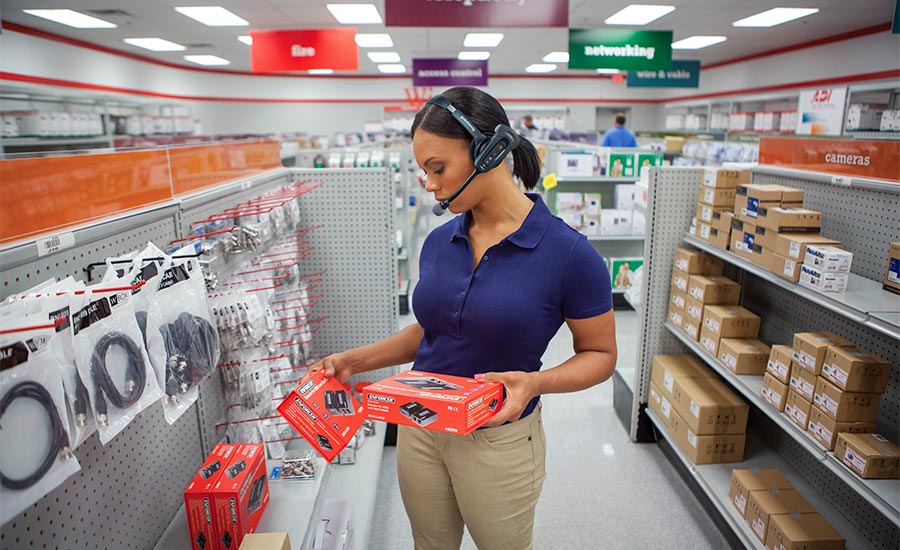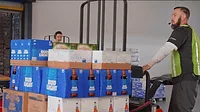Proactive solutions
Voice picking technology brings efficiency to fast-paced beverage operations
Voice-directed solutions with integrated AI offers advantages in beverage market

Image courtesy of Dematic
American filmmaker, playwright and actor Tyler Perry is quoted for saying: “There’s a huge demand for my entertainment, and I can’t meet the need. So I decided to try a TV show to reach as many of my fans as possible.”
In the same vein, when it comes to beverage operations looking to achieve greater efficiency, experts note that warehouses increasingly are turning to voice picking solutions to meet their goals.
“The market for voice picking technology is poised for continued growth,” says Brandon Duba, solution consultant at Atlanta-based Dematic. “This technology is already widely used in established warehouses, particularly in retail and eCommerce, driven by the need for more efficient picking processes.
“As warehouses face an increase in complexity and demand for higher productivity, voice picking is being used in other warehouse functions, such as put-away operations, replenishment activities and inventory management,” Duba continues. “Operations will continue to identify ways to integrate voice picking with other technologies.”
Taylor Smith, chief marketing officer for productivity solutions and services at Honeywell, Charlotte, N.C., echoes similar sentiments, noting that voice picking solutions can help boost worker performance.
“Customers are continuing to look for ways to make their operations as efficient as possible and help their workers perform tasks more easily, whether they’re in the back of the retail store or in a distribution center setting,” Smith says. “With a high-turnover workforce, they also need technology that workers can learn quickly.
“These demands are all the more important as operational complexity increases in today’s warehouses,” he continues. “Technologies like voice picking and guided work solutions help achieve these goals in fast-paced environments where seconds in time savings can add up significantly over the course of a shift.”
Smith adds that, with SKU proliferation creating many challenges for warehouse operators, transitioning from a few to many beverage SKUs requires adaptable solutions like voice-picking technology to maintain accuracy
“In today’s supply chain, speed paired with high order accuracy are essential to avoid costs associated with reverse logistics and negative customer experiences,” he explains. “For the beverage industry, if a customer’s preferred beverage is not on the store shelf, you’ve lost the sale as your consumer typically doesn’t come back the next day to see if it’s available. More SKUs means greater need for solutions like voice picking to manage customer demands while maintaining profitability.”
Dematic’s Duba explains how strongly correlated SKU proliferation and interest in voice picking technology are with each other.
“As more SKUs enter the warehouse, the pick path becomes more prolonged and less efficient. Operations will use voice picking technology to combat productivity losses by providing hands-free picking and location-directed instructions to reduce searching,” he says. “The greater SKU count can also lead to a larger number of errors. Voice picking technology dramatically improves pick accuracy for beverage operations and allows warehouses to adjust pick lines quickly at no additional cost.
“The flexibility of the [voice-picking] solution is a key advantage in inventory management as it keeps track of growing SKU counts,” Duba continues. “Real-time and location-based inventory updates from the voice pick process minimize stock discrepancies with directed and prioritized replenishment. This creates a proactive replenishment solution as opposed to a reactive one when location inventory is too low.”

Warehouse life made easier
As beverage market trends continue to impact warehouse operations, experts highlight how voice picking technology is being used to address the challenges of the day.
Honeywell’s Smith highlights that beverage warehouses and distribution centers are incorporating voice picking solutions to help address cross-industry trends such as the ongoing labor shortage, increasing labor costs, high employee turnover and profit pressure due to inflation.
“With growing product options and fluctuating seasonal demand in the beverage sector, maintaining stock consistently is vital to meet consumer needs,” he says. “Robotics and automation solutions are increasingly sought-after technologies to address labor challenges.
“To accommodate the need for faster response to last-minute orders, customers are also looking for technology that can provide a holistic view of operations and interface seamlessly with other systems, including warehouse management and execution systems and robotic solutions,” Smith continues. “Adapting various technologies working together, along with the incorporation of [artificial intelligence] (AI) and machine learning (ML), can help address the pressures faced by the beverage industry.”
Dematic’s Duba notes that omnichannel distribution continues to impact warehouse operations, causing many to find ways to effectively distribute directly to consumers, retail and wholesale.
“These varying order profiles and volumes cause significant challenges in maintaining pick efficiencies. Voice picking solutions can streamline these pick types and improve productivity,” he says. “Premiumization, product launches and health-oriented products are all the main factors that lead to SKU proliferation and the dynamically changing pick environment. Lengthened pick lines, more complex inventory management, enlarged pick errors and expanded training requirements are all results of additional SKUs.”
Duba adds that with improved technology, most notably with voice and speech recognition, voice picking solutions can streamline employee training.
“Speech recognition can understand a user’s accent or their specific mannerisms to provide faster training and easier use. Voice devices are also able to provide multi-dialect support,” he says. “User interface and training features can now be tailored to specific user needs.”
Honeywell’s Smith echoes similar sentiments, noting that AI and ML have made voice picking solutions even more efficient and accurate at interpreting employee language when speaking into a headset.
“For instance, Honeywell’s Guided Work Solutions has integrated AI, enabling the solution to understand worker speech in more than 48 different languages, despite variations in tone, dialect and pronunciation,” Smith says. “Voice technology offers a significant advantage in the beverage market by enabling hands-free operation for mobile workers when performing full case picking tasks in addition to replenishment, restocking and packing. This eliminates the inconvenience of holding a device.”
Voice picking solutions can further integrate with other automation, such as robots, AGVs, AMRs, and WMS systems. While this integration modernizes the entire operation, the future of voice picking technology will also be incorporated into machine learning and AI solutions.
A modern approach
With automation at the forefront of streamlining warehouse operations, experts anticipate that voice picking technology will be essential to beverage warehouse operations going forward.
“Voice picking solutions can further integrate with other automation, such as robots, AGVs, AMRs and WMS systems,” Dematic’s Duba explains. “While this integration modernizes the entire operation, the future of voice picking technology will also be incorporated into machine learning and AI solutions. This means better-optimized routes and functions, earlier prediction of errors, and greater analysis of operator patterns.”
Honeywell’s Smith anticipates that, with humans and automation solutions like autonomous mobile robots (AMRs) increasingly working together, safety will continue to be at the forefront for beverage warehouse operators
“Emerging technologies like vision picking and augmented reality hold great promise when combined with existing warehouse technologies, creating a collaborative robot (cobot) experience,” he says. “Voice picking technology will be vital as it allows employees to be hands-free, focusing their attention forward on each crucial task.”
Further, Smith notes that, with tech-savvy Gen Z workers representing more and more of the labor force moving forward, intuitive and easy-to-use technologies that don’t require extensive time spent on training and onboarding will become more important.
“Workers will look for solutions that can make their jobs easier, helping them to avoid unnecessary steps in workflows and succeed in their roles,” he says. “Artificial intelligence will also play a pivotal role in the future of beverage warehouses, offering workers insights into their progress and aiding in issue identification within the system and network. AI can even potentially perform self-healing tasks, contributing to smoother operations.”
Looking for a reprint of this article?
From high-res PDFs to custom plaques, order your copy today!








